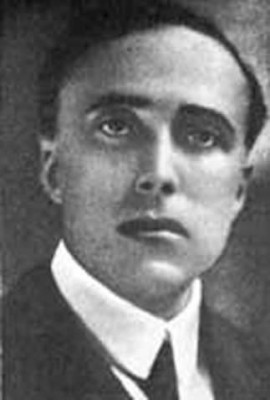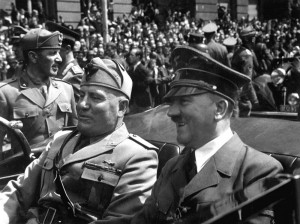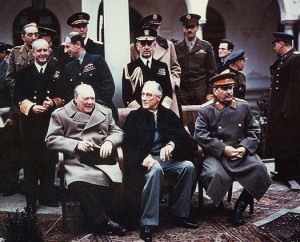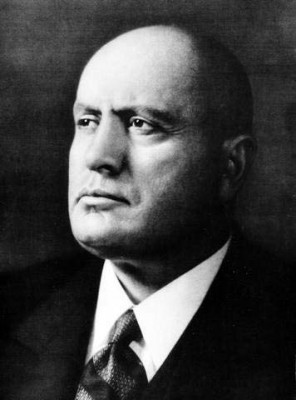 Benito Mussolini was an Italian political leader in the years before and during World War II. He was head of the National Fascist Party. Mussolini ruled Italy for more than two decades from 1922 until 1943. For most of this time Mussolini’s rule was absolute, and his powerful authoritarianism earned him the title “Il Duce,” meaning “the leader.” He was eventually deposed and executed by partisans a matter of weeks before the end of the war. He is now generally considered to have been a failure as an Italian leader, even on his own terms.
Benito Mussolini was an Italian political leader in the years before and during World War II. He was head of the National Fascist Party. Mussolini ruled Italy for more than two decades from 1922 until 1943. For most of this time Mussolini’s rule was absolute, and his powerful authoritarianism earned him the title “Il Duce,” meaning “the leader.” He was eventually deposed and executed by partisans a matter of weeks before the end of the war. He is now generally considered to have been a failure as an Italian leader, even on his own terms.
Early Life
Mussolini was born in the small town of Dovia di Predappio, in the Forli region of Italy, on July 29, 1883. The eldest of three children, he was the son of a blacksmith named Alessandro. His father was devoted to the cause of socialism and spent the majority of his spare time in politics and providing for the family. His mother, who was named Maltoni, was a very different character. She was a devout Roman Catholic teacher at a local school. Her income allowed the Mussolini family to keep some stability in their lives.
The young Mussolini had a considerable amount of intelligence, but he balanced this with frequent displays of disobedience and boisterousness. This was exacerbated by his father, who encouraged his young son to rebel against authority, especially in the cause of his beloved socialism. Mussolini was told to leave a number of schools after gaining a reputation as a bully who would refuse to submit to the authority of his teachers. Despite this, in 1901 he received a certificate to teach, spending a short time as a teacher himself.
World War I
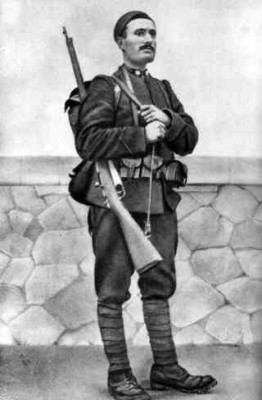 Beginning in 1904, the young Mussolini spent the years before the outbreak of World War I as a journalist. He was fairly successful in this profession, rising to the position of editor at the newspaper Avanti. At this time, Mussolini was still quite an active socialist; however, he shifted his allegiance to the right with the outbreak of war in 1914, objecting to the Italian government’s lack of support for the Triple Alliance. The following year, he left the Socialist Party altogether in protest of its support for the Allies.
Beginning in 1904, the young Mussolini spent the years before the outbreak of World War I as a journalist. He was fairly successful in this profession, rising to the position of editor at the newspaper Avanti. At this time, Mussolini was still quite an active socialist; however, he shifted his allegiance to the right with the outbreak of war in 1914, objecting to the Italian government’s lack of support for the Triple Alliance. The following year, he left the Socialist Party altogether in protest of its support for the Allies.
Once Italy itself entered the war, Mussolini spent some time serving with the Italian army. He was promoted as far as corporal, but then sustained a wound which necessitated his return home. He found a job editing the rightist newspaper Il Popolo d’Italia. The paper vocally supported Italy’s position at the Paris Peace Conference, insisting that the Allies should support its position. Once the war was over, Mussolini strongly criticized Vittorio Orlando for his failure to gain a better outcome for Italy in the Treaty of Versailles of 1919.
Becoming a Fascist Organizer
Mussolini now played a part in organizing the splintered right wing of Italian politics, molding the often argumentative groups into the new Fascist Party. 1922 saw a number of riots in the country, and King Victor Emmanuel III responded by giving Mussolini the job of leading the country in order to stop the perceived threat of communist revolution. His somewhat unwieldy coalition was made up of a variety of fascists and nationalists. The group held together well enough for the party to feel reasonably secure in maintaining control of parliament.
In 1924, Giacomo Matteotti, the leader of the Italian socialists, was murdered. This event saw the end of democratic government in Italy. At first, leftist parties were simply suppressed, but in 1929 the country officially ended any pretense of being a multi-party state. From then on, the Fascist Party would be the only political organization allowed in parliament. Mussolini himself enjoyed considerable popularity at this time, in particular because of the rise in employment that he had achieved by means of introducing a wide-ranging program of public works.
Africa
When Mussolini came to power, Italy’s African colonies consisted of just Somalia and Eritrea. The country had attempted, without success, on a number of occasions to take control of Ethiopia, which bordered both its existing territories. Mussolini, who was determined to demonstrate that his regime was a strong and powerful one, decided that he would send Italian troops into Ethiopia in order to colonize it. In October, 1935 he sent the army, commanded by General Pietro Badoglio, across the Ethiopian border to launch their invasion.
The aggression that Italy had shown by taking this step brought swift condemnation from the League of Nations. A month after the Italian invasion had been launched, the League imposed a number of sanctions on Italy, the most important of which concerned a ban on the supply of arms, certain metals, and rubber. Several high profile political figures in the United Kingdom and France were opposed to the imposition of sanctions, on the grounds that such a move might prompt Mussolini to make common cause with Nazi Germany.
The army that Mussolini had dispatched to Ethiopia was an extremely strong force, consisting of close to half a million troops. The Ethiopians, who were poorly armed and supplied, had no answer to the aircraft and tanks that were pitted against them. Mussolini controversially ordered that mustard gas should be used against the defending Ethiopians, a move which contributed to his forces capturing the capital city of Addis Ababa in May 1936. Haile Selassie, the country’s emperor, was forced to leave the country and go to Britain.
Alliance with Hitler
After seeing the military achievements of Mussolini’s regime, Adolf Hitler had been sufficiently impressed and pushed for a closer relationship between Italy and Germany. The two countries signed a treaty in October, 1936, although at this stage it did not involve military co-operation. In 1939, however, Italy launched a successful invasion of Albania. Shortly after the conclusion of this mission, Mussolini and Hitler signed what became known as the Pact of Steel, a defensive military alliance. Despite this agreement, Italy’s declaration of war on France and Britain was delayed until June 10, 1940.
Italy had more than a million men under arms in Libya, and Mussolini realized that they could be used to attack the strategically crucial Suez Canal in neighboring Egypt. The British defenders of the canal and the nearby oil fields of Arabia numbered less than 40,000. On September 13, 1940, five divisions of the Italian army, led by Marshall Rodolfo Graziani, began a speedy advance into Egypt. However, they ceased their advance at Mersa Matruh, a little ways away from the bulk of the British defensive fortifications.
Military Failures
Italy declared war on Greece in October, 1940, but the army’s attempt to invade the country proved to be entirely unsuccessful. Meanwhile, the conduct of the war in north Africa was also failing to live up to Mussolini’s expectations, as the British forces under, General Archibald Wavell, mounted a counter-attack on December 9th. Although the Italians had a substantial advantage in terms of sheer numbers, they were nevertheless forced to pull back a full 500 miles, having taken very significant casualties. British soldiers then took advantage of the Italian retreat, and in late January, 1941, the key Libyan port of Tobruk fell to them.
Thanks to a combination of these military failings, and a variety of domestic problems, Italy had become utterly dependent on the Germans for its operation by the end of 1941. Galaezzo Ciano, the Italian foreign minister, became more and more unhappy with Mussolini’s conduct in running the country and the two men had a number of bitter quarrels. By February 1943, Ciano’s situation had become completely untenable, and he resigned from the government.
The Allied Invasion of Sicily
United States president Franklin D. Roosevelt and British prime minister Winston Churchill, meeting at the Casablanca Conference, were eager to find a way to remove Italy from the war altogether. After long discussion, the two men agreed that the first step should be an invasion of the Mediterranean island of Sicily. The hope was that a successful capture of this island would demoralize the fascists, and that it would prompt the Italian population to force Mussolini out of office. The argument was also made that the invasion would compel Hitler to transfer some of his forces from the Eastern Front, thereby giving an advantage to the Soviet army.
The supreme command of the Sicilian invasion mission was given to the American general, Dwight D. Eisenhower, with General Harold Alexander taking control of ground operations. The 15th Army Group, which was to conduct the invasion, included men such as the British general Bernard Montgomery of the Eighth Army and, from the United States, General George Patton of the Seventh Army. Air Marshal Arthur Tedder was placed in command of airborne operations, while Admiral Andrew Cunningham was to control events at sea. Mussolini’s forces numbered tens of thousands, and were backed by a similar number of German troops, so a hard fight was expected.
The Eighth Army made landings in five locations in southeastern Sicily on July 10, 1943. Meanwhile, the Seventh Army landed on three beaches, all located some way to the west. The Allied forces were surprised to encounter very little active resistance, and Patton’s men managed to capture the towns of Vittoria, Licata, and Gela fairly rapidly. Meanwhile, the British forces also met little opposition, and the city of Syracuse was taken before nightfall. Over the next few days, the towns of Palazzolo, Augusta, and Vizzini also fell. American soldiers captured the town of Niscemi and the airfield at Biscani.
The arrest of Mussolini
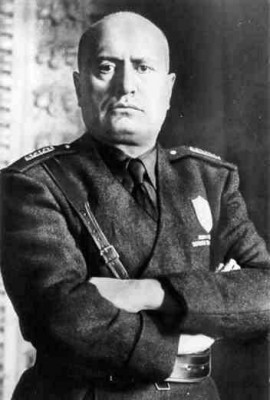
The Allied advance into Sicily continued at a considerable rate, with the Germans being forced to retreat as Patton’s men cut off 50,000 Italian soldiers in the Sicilian west on July 22, 1943, before rushing along the north coast toward the key port of Messina. The Axis forces succeeded in carrying out a large-scale evacuation of more than 100,000 Italian and German troops, but the island of Sicily was entirely lost to them. This gave the Allies the stepping stone they needed to launch an invasion of mainland Italy.
With this heavy defeat, Mussolini came under very serious pressure. The Fascist Grand Council was convened on July 24, with Ciano’s proposal that Italy should negotiate armistice terms with the Allies , independent of Germany, being quite well received. One day later, Mussolini was informed by King Victor Emmanuel III that he had been dismissed, to be replaced by Pietro Badoglio. The new leader immediately declared a state of martial law and had Mussolini arrested.
Escape from Captivity
On July 29, Hitler met with Otto Skorzeny, and the two men discussed whether it might be possible to free Mussolini from his captivity in the Abruzzi Apennines. The decision was made to go ahead with the rescue attempt, and on September 13, Skorzeny, in command of an airborne commando unit, launched an assault on the hotel which was known to hold Mussolini. The operation was a success, and the deposed Italian leader was flown to a safe location north of the country.
Once safely in the north, which was still occupied by the Germans, Mussolini announced the setting up of the so-called Salo Republic. As soon as he had done this, Mussolini set in motion events that led to the arrest of five men who had opposed him in the earlier vote of the Fascist Grand Council. This included Galaezzo Ciano, despite his status as Mussolini’s son-in-law. All five of the men arrested were executed as traitors to the cause of fascism.
Recapture and Execution
The Allies liberated Rome on June 4, 1944, going on to capture the rest of Italy. With the Allies closing in, Mussolini and Claretta Petacci, his lover, made an attempt to reach Switzerland, but elements of the Italian underground intercepted him, finally capturing Mussolini on April 27, 1945. The following day, in the town of Mezzegra, they were both executed. Their bodies were put on public display in a square in Milan, hung upside down to maximize their humiliation. The Italian people generally saw little reason to grieve over a man whose promises of glory had brought their country military defeat.
